Apple's HomePod speaker: Either way late or way early
Apple (AAPL) has never been ashamed to be late to the party. The iPod wasn’t the first pocket music player; the iPhone wasn’t the first cellphone; the Apple Watch wasn’t the first smartwatch. But in each case, Apple won the category by making its product better.
On Friday, you’ll be able to buy the HomePod, Apple’s answer to the smart speakers from companies like Amazon, Google, and Sonos. It is indeed way late to the party, even by Apple’s definition — last June, Apple said that it would ship the HomePod in time for the holidays.
But the HomePod is better only in the “speaker” sense. Despite all of those delays, despite the chance Apple has had to study its rivals, despite the fact that Apple says it’s been working on the HomePod for six years, the “smart” part of this speaker is way behind.
Which is so weird. Apple’s voice assistant, Siri, was born before Alexa, “OK Google,” and Cortana. It had a huge head start. It has no excuse now for being the dumbest smart assistant on the market.
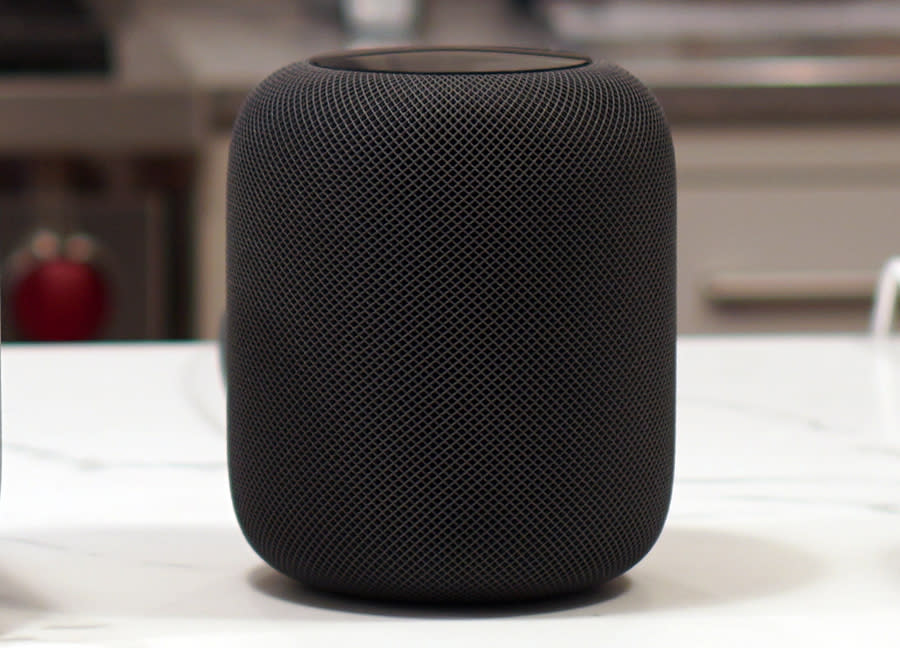
Music first
You hear people shrieking about the HomePod’s price, which is $350. “I could get an Amazon Echo Dot for $40!”
Well, yeah. And instead of buying a Tesla, you could buy a bike off of Craigslist. It’s just not the same thing.
This thing is built. It’s a heavy, squat cylinder (6.8 inches by 5.6 inches), available in black or white. Rubber on the bottom, cloth mesh around the sides, touch-sensitive screen on the top. Even the power cord is dressed up.
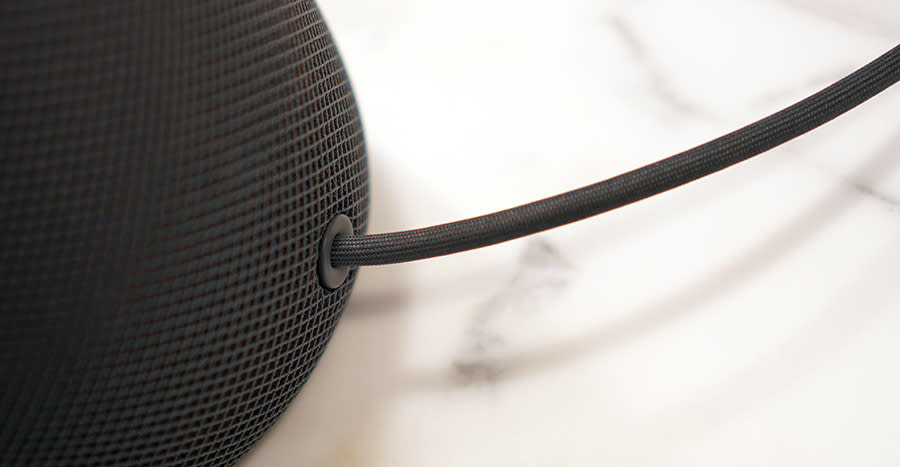
The touchscreen on the top never displays words or recognizable pictures; it exists solely to offer a cool, colorful swirling LED light whenever HomePod is speaking or listening. Then it goes black.
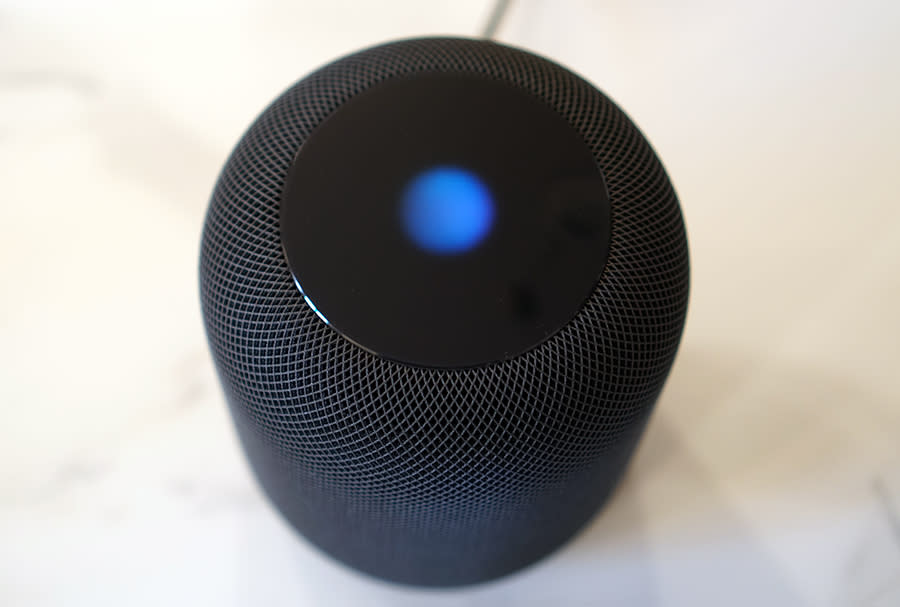
Setting up the HomePod is incredibly easy: You just bring your iPhone near it and tap Set Up.

After a few setup screens (including, inevitably, an Apple Music ad), your Apple account password and home Wi-Fi password get transmitted automatically, and then you’re good to listen.
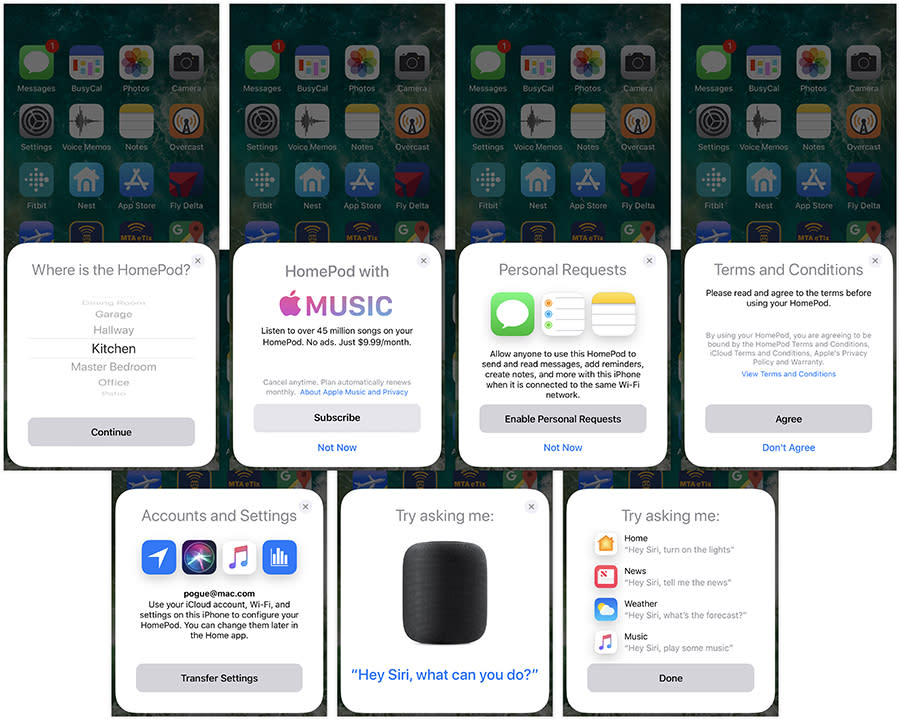
Assuming you’re among the 40 million subscribers of the Apple Music service ($10 a month), you’re in for a glorious ride. You can ask it to start playing music by genre, band, song name, album name, whatever. “Hey Siri — play Coldplay.” “Hey Siri — play me some 80’s dance tunes.” “Hey Siri — play ‘The Wall.’” “Hey Siri, next track.” “Hey Siri, volume up.” “Hey Siri, stop.”
You tap the top to pause playback, or tap + and – to adjust the volume. You can also double-tap for “next track,” or triple-tap for “previous track.”
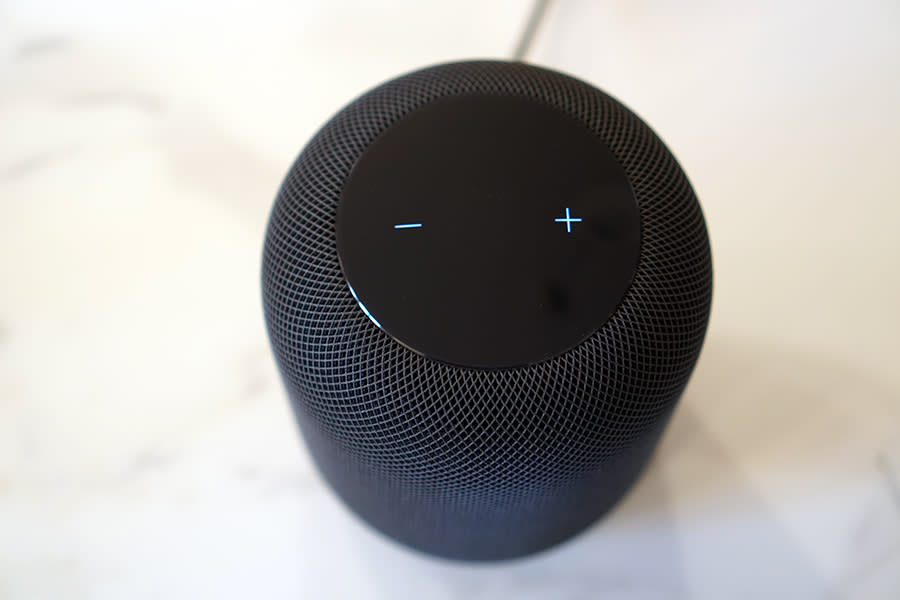
The audio quality will floor you. Let’s just get one thing straight: The HomePod sounds better than the Google Home Max ($400), the Sonos One ($200), or the Amazon Echo Plus ($150), let alone all the smaller Echos and Google Homes. This isn’t a matter of opinion; it seems to be a universal consensus among critics, and also my own reaction, based on side-by-side blind listening tests offered at an Apple suite in New York. (I also conducted my own test, with listeners from all walks of demographics. it had very different results, as you can see here.) The HomePod has the most balanced midrange, the most detailed highs, and a crisp, muscular, musical bass the other little guys can’t touch.
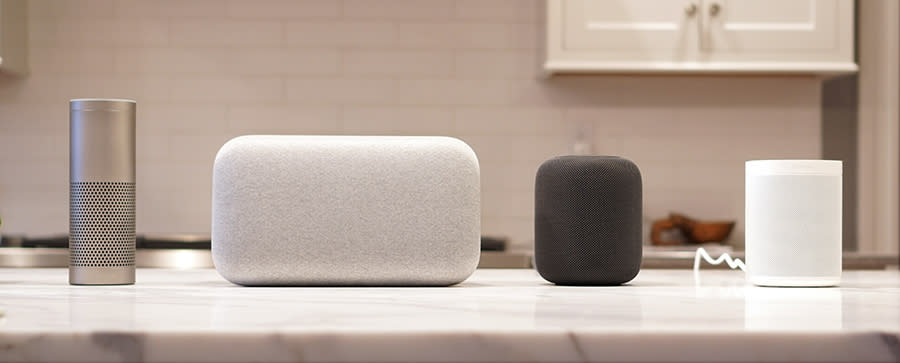
Maybe that’s because the HomePod contains seven tweeters, arrayed in a circle, and a gigantic, 4-inch woofer, capable of moving 0.8 inches, pointing out the top. Or, as Apple describes it, “array of seven beam-forming tweeters, each with its own amplifier and transducer. And each custom designed with a precision acoustic horn that focuses sound for tremendous directional control.” But you knew that.

At top volume, the HomePod is powerful enough to fill your entire downstairs, or your entire yard. It gets really loud — so loud that Siri asks if you’re sure you want to crank it that loud before doing so. And guess what? It doesn’t distort at 100 percent, like the Google Home Max does.
The HomePod also contains six microphones. They’re designed to pick up your voice commands even when you’re across the room, even when it’s blasting music. (My 13-year-old is fond of subjecting his parents to the following prank. He tells our Amazon Echo: “Alexa, play ‘Who Let the Dogs Out’ at 100% volume.” The Echo complies — but at that point, it’s impossible for it to hear any further commands! There’s no way to stop it except to get off the couch, march over, and tap it. The HomePod, on the other hand, can always hear you. You can say: “Hey Siri — tell me about this album.” “Hey Siri — who’s this singer?” “Hey Siri — play more like this.” And so on.)
But Apple says that the six microphones also serve to sample the proximity of the walls and ceilings around it. It instantly reconfigures what’s coming out of those seven tweeters so that the important stuff, like the band and the singers, come out toward the room, and the ones on the sides handle reverb, applause, and the like.
I don’t know about all that — there’s really no way to tell if all that’s happening. But never mind. The HomePod sounds really, really great.
Siri second
If you’re among the 39 million Americans who own an Amazon Echo or Google Home, you already have certain expectations of the things it can do for you. You can ask about sports, weather, news, measurements, facts, timers, reminders, and so on.
And you can voice-control your home, to the extent that you’ve bought Apple HomeKit-compatible thermostats, lights, and so on. Unfortunately, Google and, especially, Amazon are way, way ahead on smart-home compatibility. Siri can’t even control anything from Nest, which is probably the most popular brand.
But the sad, stunning fact is that the HomePod can’t do a lot of the things that the other speakers can— or even things Siri on your iPhone can. It can’t call you an Uber. It can’t tell you what’s on your calendar. It can’t set up more than one timer at a time (sorry, kitchen chefs). It can’t check your email.
It also can’t make free speakerphone calls to any number without needing a phone, the way the Amazon Echo and Google Home can. You can use the HomePod for dictating texts and reading incoming ones, if your iPhone is within range; and the HomePod can be a speakerphone for the iPhone.
But the HomePod can’t tell apart different voices in your family, the way the Google and Amazon speakers can. So if the texting feature is on, there’s nothing to stop other people from sending texts “from you” while you’re in the shower, or listening to your incoming texts when you’re upstairs. For a company that touts its dedication to personal privacy, Apple dropped the ball on this one.
Oh, and while we’re categorizing our disappointments: You can’t set up two HomePods as a stereo pair, as you can with Google or Sonos smart speakers. Nor is the HomePod multi-room; you can’t say “Play Barry White in the bedroom,” as you can with its rivals. Apple says that both of those features will come later in the year. (What exactly were you doing during those six years, Apple?)
Velvet handcuffs
The most astonishing limitation of the HomePod is that you must own an iPhone, iPad, or iPod Touch to set it up, and you must be an Apple Music subscriber to voice-control music. (It can also play what’s in your iTunes or iTunes Match libraries.) Unless you’re all-in on Apple, you can’t even use this thing.
That’s right. Apple’s $350 smart speaker has never heard of Spotify, the music service that’s twice as popular as Apple Music (70 million subscribers). No Spotify, no Pandora, no Google Play, no iHeart Radio.
The HomePod isn’t a Bluetooth speaker, either, so you can’t connect any old phone to it.
Now, you can start up non-Apple services on their various iPhone apps and send the playback through the HomePod. But you can’t command them by voice, which is the whole point.
“Totally understandable,” you might say. “Apple runs a music service — they want to drive customers to that.” Well, sure, but so do Google and Amazon. Yet their speakers let you control Spotify and other services by voice. And they don’t require one phone brand or another.
For most people looking for a smart speaker, I’d recommend the Sonos One (here’s my review). Its audio quality is just shy of the HomePod’s (you’d notice a difference only in a direct A/B comparison test). It contains Amazon Alexa and “OK Google.” It’s multi-room, it’s stereo-pairable, and — here’s the kicker — you can buy two for the price of a single HomePod.
Bringing HomePod
Being late to the party is an Apple hallmark — but so is starting out with a lame 1.0 version. The first iPod worked only with Macs, not Windows. The first MacBook Air was painfully slow. The first Apple Music app was a hot, confusing mess. And how about the Apple Watch 1.0? Yeah — nobody touched it.
Maybe that’s the master plan for the HomePod, too.
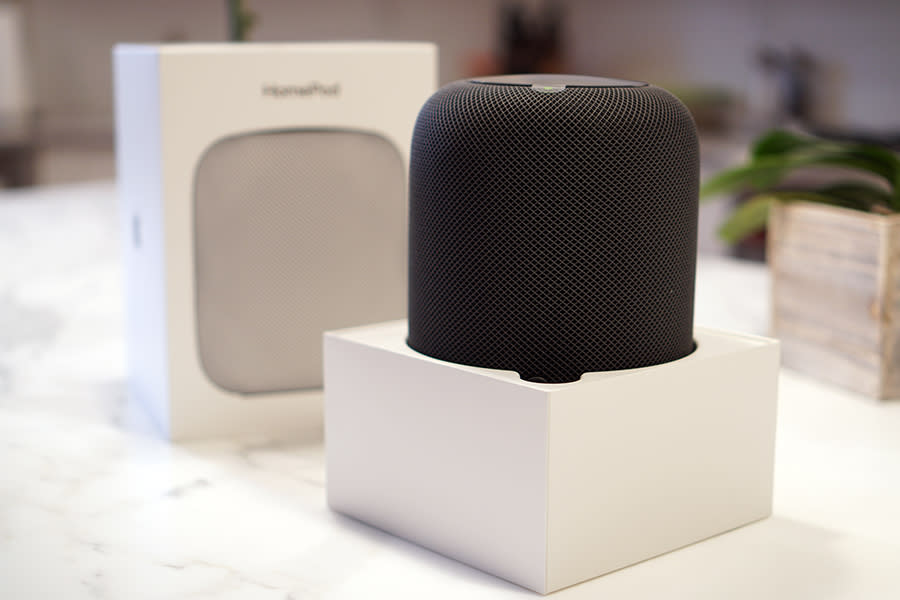
We already know that Apple is working on letting you use two in a stereo pair, and developing multi-room features (“Hey Siri, play Taylor Swift in the playroom”). So maybe Apple’s also assembling a team of voice engineers to bring Siri out of its 2011 rut. Maybe a software update will bring speaker-independent voice recognition, so each family member can ask about their own calendars, texts, and playlists. And maybe Apple’s lawyers are furiously hammering out the deals with Spotify and Pandora even as we speak.
Until then, the HomePod sounds amazing only in the literal sense. Otherwise, it’s best suited only to a core audience of true-blue Appleheads: people who use the iPhone, signed up for Apple Music, and, preferably, live alone.
In other words, maybe the HomePod isn’t late to the party. Maybe it’s just really, really early.
David Pogue, tech columnist for Yahoo Finance, welcomes non-toxic comments in the Comments below. On the Web, he’s davidpogue.com. On Twitter, he’s @pogue. On email, he’s [email protected]. You can sign up to get his stuff by email, here.
Read more:
David Pogue’s sneak preview of the Apple HomePod
Pogue’s Apple TV 4K live unboxing
Reviewers discover that the Apple Watch Series 3 can’t get online
